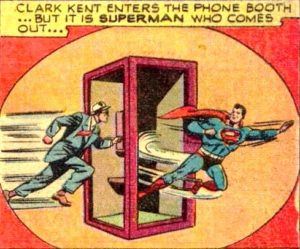Diegesis. di-e-ge-sis. [ˌdīəˈjēsis]. a narrative or plot, typically in a movie. But more importantly it's
what happens IN the movie. In Pulp Fiction there's a dance contest scene set to Chuck Berry's "You Never Can Tell." That song/music is diegetic to the movie. "Out of Limits" is played near the end of the film as Butch rides off with his girlfriend. It is pure soundtrack. NOT diegetic.So what does this have to do with D&D? As Prismatic Wasteland put it in their post back in '21 "Your
character’s broken leg is a diegetic injury, but losing their hit points is not." I've always been a fan of diagetic character growth as opposed to non-diegetic. Non-diegetic, to tie in to a post I made last week, is like Clark Kent dashing into a nearby phone booth and then bursting out as Superman. Characters go into a battle at second level, kill a kobold or two and emerge as third level. More hit points. More spells. More abilities. I've always HATED that. Imagine going to high school, sitting in classes for four year, but not acquiring any knowledge or skills until the end when they hand you a rolled up piece of paper. Makes no sense.So what's the solution? My return to the game has allowed me to read a crap-ton and keep my eye out for potential solutions. Some are simply procedural. I've become more aware of my spell-casters needs and manage to seen spells, books and scrolls in advance of a PC being able to use them. In our last session I knew that three PC's were QUITE close to getting the XPs they'd need to go from 1st to 2nd. So I kept one eye on the XPs they earned and when they crossed the threshold, in media res, their class features manifested. The Twilight Cleric was bathed in twilight and those around him felt relief, their fear was allayed and some gained hp. The Circle of Spores Druid manifested her Halo of Spores and inflicted necrotic damage on her opponent. Made for a nice cinematic moment. All at the table loved it. And they'll get the rest of the rights and appurtenances thereto between sessions. But still only a very small band-aid on a much larger "problem." I do have two potential fixes, however.
Regular readers know I've abandoned feats and instead use the Smolensk Sage System. When a PC advances a level there are rolls for each area of study to see what, if any, knowledge is obtained. And it's all applied at once. A player might acquire a handful of new skills all at once. Or nothing. So I'm going to try a little play test this next level. I'll do all the rolls in advance, note the result and total the outcome. Then as players advance toward the next level after each session I'll allocate the points randomly. So instead of dashing into the phone booth after a successful interaction with the head of the cartographer's guild the abilities can be acquired a little at a time and introduced between sessions. That way every XP counts, not just the last one. You never know when some new skill/feat is going to fall into your lap so long as you are progressing.
And the OTHER mechanic I recently stumbled on, via the above-linked post, is that of Ability Score improvements. RAW you go adventuring and when you wake up at 4th level you're suddenly better at two of the six things you can do. Whether you've used it or not. Makes no sense. I've been playing Sid Meyer's Civilization since Civ 1. Unit's get promotion but you decide what they are. Scouts are the first unit's you get. When promoted they can get either a movement bonus through forests or over rough terrain. In other words you can spend every turn marching over hilly rough terrain earning exploration XP but when you get your promotion you can improve your forest movement. Makes no sense.
So let's steal a mechanic from Freebooters on the Frontier (2.) Any time the player tries to do something using one of the six abilities and fails they get a tic. Five tics and they increase the AS by 1. OK. Not EVERY time. A nat 1 is a critical failure and nothing good come from that. But a 2? That earns a tic. Same for failure by 1 (? not sure about this.) I'll play test and see what happens. Fighting, casting and skill uses all count. There's a 10% chance of getting a tic so the fifth tick should come after roughly fifty tries. Assume a fighter. Most of our combats are successfully resolved in 3-5 rounds. So 10-15 combats. RAW bumps the AS every four levels. That would break down to 3-4 combats per level. Spellcasters likely have fewer chances but should have more opportunities using other skills. And this way there's no dashing into the phone booth. There's merely a nice step of progress for using your abilities - the high AND the low.
Would love to hear thoughts and input. And I'm wondering: do I tell the players or just let them find out as they get the boost?

